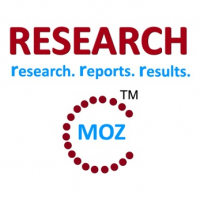Non-Small Cell Lung Cancer Therapeutics in Asia-Pacific Markets Key Trends, Size, Growth, Shares and Forecast 2023
Researchmoz added Most up-to-date research on "Non-Small Cell Lung Cancer Therapeutics in Asia-Pacific Markets to 2023 - Launch of Premium Targeted Therapies and Increasing Prevalence to Drive the Market" to its huge collection of research reports.

Albany, NY -- (SBWire) -- 08/25/2017 --Non-Small Cell Lung Cancer (NSCLC) is the most common cancer and the leading cause of cancer-related mortality globally. There were more than 1.8 million newly diagnosed lung cancer cases in 2012, accounting for 13% of the total number of cancer cases. This figure has been gradually rising with increased smoking and the growing elderly population. Lung cancer is a leading cause of death worldwide, accounting for 1.69 million deaths in 2015. Over half of the incident cases of NSCLC are diagnosed in patients over the age of 65 a high-risk age range for lung cancer. As the aged population is projected to grow, the prevalence of lung cancer is anticipated to increase, acting as a driver for revenue growth.
To Get Sample Copy of Report visit @ http://www.researchmoz.us/enquiry.php?type=S&repid=1049126
The poor prognosis, particularly for patients with advanced disease, has created a pressing need for improved therapeutic options. The NSCLC market is therefore shifting from a focus on generic chemotherapy regimens to a complex treatment landscape based on different NSCLC subtypes, and the presence of various molecular aberrations.
In the current market, patients with non-squamous histology can be treated with more efficacious therapies such as Alimta, while patients harboring activating mutations in EGFR or ALK can be prescribed targeted therapies such as Tarceva, Iressa, Gilotrif, Conmana, Xalkori, Alecensa and Zykadia.
Opdivo and Keytruda are mAbs, immune checkpoint inhibitors targeted towards programmed cell death (PD) 1, and are recent market entrants. The former gained approval for treating advanced or metastatic squamous NSCLC in Japan in 2015 and in Australia and South Korea in 2016, and the latter gained approval in Japan in 2016 for the firstand second-line treatment of patients with PD-L1-positive unresectable advanced/recurrent NSCLC. Tagrisso and Olita EGFR inhibitors that targeted towards EGFR T790M are also recent market entrants, with the former gaining approval in Japan, Australia and South Korea, and the latter approved in South Korea in 2016 for advanced or metastatic patients with EGFR T790M mutation-positive metastatic NSCLC.
There are currently limited options for patients with squamous cell histology or other detectable molecular characteristics besides EFGR and ALK mutations. A therapy that targets mutant KRAS abemaciclib is being developed in the pipeline.
Browse Detail Report With Full TOC @ http://www.researchmoz.us/non-small-cell-lung-cancer-therapeutics-in-asia-pacific-markets-report.html
Scope
The NSCLC Asia-Pacific market will be valued at $6.2 billion in 2023, growing from $3 billion in 2016 at a CAGR of 10.8%.
- How will immunotherapies such as atezolizumab contribute to growth?
- What effect will patent expirations of currently branded therapies have on market value?
- The NSCLC pipeline is large and diverse, with an increased presence of mAbs and targeted therapies.
- What are the common targets and mechanisms of action of pipeline therapies?
- Will the pipeline address unmet needs such as limited treatment options for squamous cell patients?
- What implications will the increased focus on targeted therapies have on the future of NSCLC treatment?
- Numerous late-stage pipeline therapies with a strong clinical record have the potential to enter the market over the forecast period.
- How have the late-stage therapies performed in clinical trials?
- How would the approval of abemaciclib to treat KRAS mutant patients affect the competitive landscape, with no targeted therapy currently available to address this patient subset?
- The market forecasts indicate that Japan will contribute the most to the Asia-Pacific market value due to the emergence of novel therapies.
- How will the annual cost of therapy and market size vary between the five Asia-Pacific markets?
- How could changes in risk factors such as population age, smoking habits and pollution influence the market?
- Licensing deals are the most common form of strategic alliance in NSCLC, with total deal values ranging from under $10m to over $1 billion.
- How do deal frequency and value compare between target families and molecule types?
- What were the terms and conditions of key licensing deals?
Reasons to buy
This report will allow you to -
- Understand the current clinical and commercial landscape by considering disease pathogenesis, diagnosis, prognosis, and the treatment options available at each stage of diagnosis, including a clinical comparison of marketed therapies.
- Visualize the composition of the NSCLC market in terms of dominant therapies for each patient subset along with their clinical and commercial standing. Unmet needs are highlighted to allow a competitive understanding of gaps in the current market.
- Analyze the NSCLC pipeline and stratify pipeline therapies by stage of development, molecule type and molecular target.
- Understand the potential of late-stage therapies with extensive profiles of products that could enter the market over the forecast period, highlighting clinical performance, potential commercial positioning, and how they will compete with other therapies.
- Predict NSCLC market growth in the five Asia-Pacific markets, with epidemiological and annual cost of therapy forecasts across India, China, Australia, South Korea and Japan, as well as the individual contributions of promising late-stage molecules to market growth.
- Identify commercial opportunities in the NSCLC deals landscape by analyzing trends in licensing and co-development deals.
Make an Enquiry of this report @ http://www.researchmoz.us/enquiry.php?type=E&repid=1049126
Media Relations Contact
Mr. Nachiket
Manager
Researchmoz Global Pvt. Ltd.
518-621-2074
http://www.researchmoz.us/non-small-cell-lung-cancer-therapeutics-in-asia-pacific-markets-report.html
View this press release online at: http://rwire.com/853586